The Mandalorian - Season 2
VFX Workload: 883 shots
Cumulative Duration: 1h24 minutes
VFX Description: design, layout, lighting, texture, modelling, animation, FX, compositing.
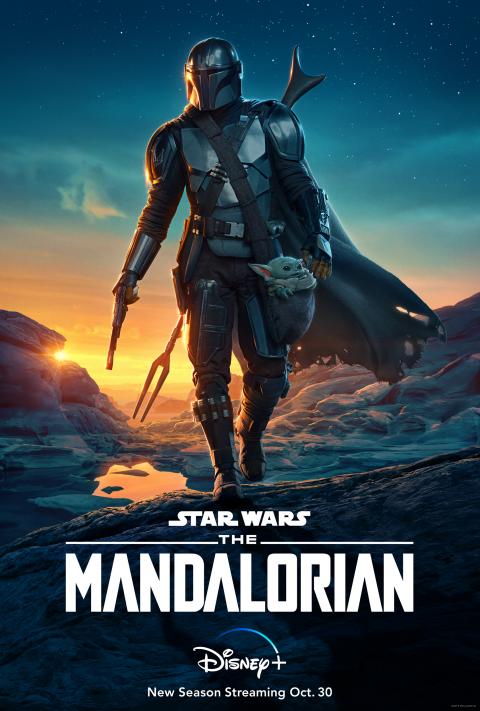
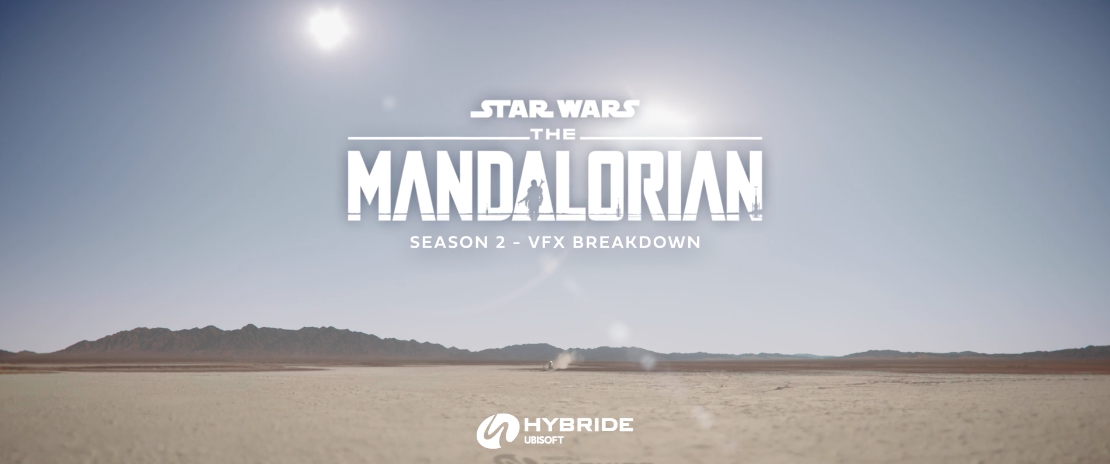
Creating hard surface characters
Dark Troopers
The Mandalorian season 2 finale, "Chapter 16: The Rescue," showcased the full capabilities of the Imperial Dark Troopers after two brief previous appearances, and brought the Star Wars Legends versions of them more fully into canon. In addition to showing their offensive and defensive abilities, the finale also provided exposition for the history of the Dark Troopers under Moff Gideon's command.
Hybride ingested ILM assets to produce the deadly robots for the scene where Moff Gideon (Giancarlo Esposito) deploys the Dark Troopers within a cold storage room located on the cruiser. "The room is filled with these Dark Trooper robots," said Hybride VFX Supervisor Joseph Kasparian, "and they are attached to the walls with wires. When Mando pushes a button, the Dark Troopers sort of unfreeze and come to life, and then you see them coming out of the walls, moving towards Mando."
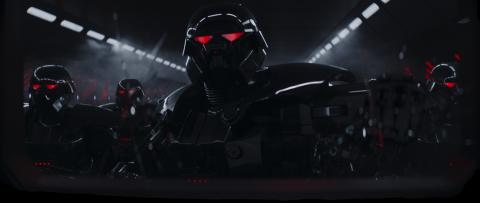
Mando takes on a Dark Trooper outside the cold storage room in a sequence that had about 70 shots from Hybride. "There were super closeups of the robot and of Mando as he is thrown around," recalls Kasparian, "and very often they were full CG. Like the work we did with L3 (Solo: A Star Wars Story), they shot the actor wearing a robot suit for the fight and they wanted us to keep as much as we could of the performer, and replace parts of the suit. But the suit would often move in all directions in the plates, so we used it as a reference for many shots. Still, there was so much happening with the action and framing in this fight, it was very important to keep the performer's choreography, which we tried mimicking with our CG Dark Trooper. However, the way the Dark Troopers move and punch is very mechanical, and the guy in the suit wasn't able to move in a mechanical way so we added that look on our side."
Pit Droids
As we travel to the deserts of Mos Eisley where The Mandalorian lands at bay three-five where three DUM-series pit droids rush out to service the Razor Crest, the droid hating Mandalorian fires a warning shot, causing the pit droids to retract. His shots anger his old friend Peli Motto, who warns him that if he damages one of her droids, he'll pay for it.
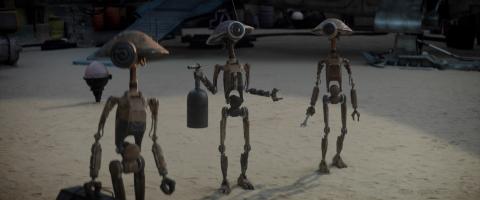
Hybride artists animated and articulated the pit droids who provide a touch of comic relief with their clumsy and playful antics as the main characters discuss in the foreground. "We tried to keep them as close as possible to what they were in the first season," commented Joseph Kasparian.
"In the original brief, Jon Favreau suggested that the droids could play around with the Razor Crest then the doors could open and all the wires would come spilling out and one of them would get its face sucked in by a tube. Our team did all the animation for those shots."
HK Droid
The HK-87 assassin droid was a model of assassin droid. During the time of the New Republic, Magistrate Morgan Elsbeth utilized two such droids in her army while ruling over the city of Calodan on the forest planet Corvus.
Based on artwork provided by the production's art department, Hybride artists created a model of the droid for the sequence where Mando meets the Magistrate (Diana Lee Inosanto) in the courtyard on Calodan Street. As the Scout Guards escort Mando to the Magistrate, the compound's gates open, revealing a courtyard in shots produced by Hybride.

"It was a big set built with a pond surrounded by a wall," explained Joseph Kasparian, "we created set extensions which were mainly buildings and roof tops, to help establish the city of Calodan behind the wall. "We also designed and animated the fully CG Droid that sort of looks and moves like a soldier, so we needed to do a bit of motion study to get the movements right."
Creating hyper realistic environments
Cruising on Mos Pelgo
With the covert on Nevarro abandoned, Mando (Pedro Pascal) is cut off from his kind, and he's searching for other Mandalorians who can help him with his quest to take the Child to the Jedi.
Hybride produced set extensions, particle FX, CG backgrounds and speeder bike trails for traveling shots throughout different locations as Mando heads towards Mos Pelgo, a town located on the Outer Rim planet of Tatooine. R&D was required to develop the look of the speeder bike trails based on assets provided by ILM.
The CG landscape, filled with dunes and volcanic ground structures, was built based on ultra hires photogrammetry scans taken from locations in Chile. The Hybride team extended backgrounds from the main plate and then proceeded to enhance whatever was on the ground, ensuring proper interaction with each element.
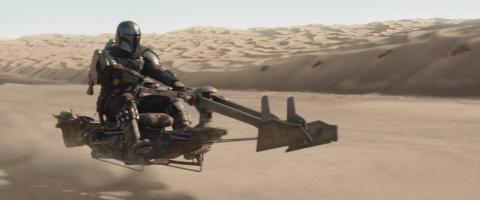
"We didn't have to augment the plates, except to add CG dust trails behind the speeder, and ensure proper interaction with the ground," noted Joseph Kasparian. "We were going to have many of these types of shots throughout several episodes, so we had to establish the look of the dust trails seen from afar and in super close-ups."
To recreate the city of Mos Pelgo, Hybride artists extended the partial set that had been built by the production team and also recreated completely CG buildings and environments. For some scenes, the studio also produced a fully CG Mando and speeder bike as he hovers over desert plains.
Desert walk
As Mando zips through the desert on his speeder bike he ends up in an area where the rocks get increasingly closer so he is forced to go in the middle of two rocks were bounty hunters are waiting for him. Hybride artists integrated a CG Mando and speeder into the plates, and also created the CG environment for the bandits' trap.
"There was a partial set and maybe one rock that was about 10' high x 15' wide and from there we had to create a set extension and a whole environment where a fight between Mando and a Bounty Hunter would take place," noted Kasparian. "Jon Favreau wanted to use as much location photography as possible for the sky and mountains in the background, and mountains that were in the middle ground would be from photogrammetry."
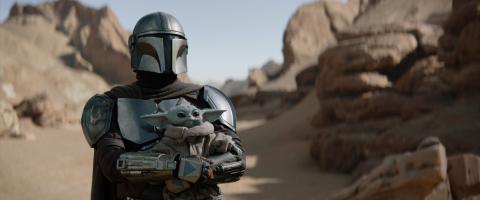
CG mountains and terrain were created using a huge library of assets retaining as much of the live material as possible. "Whatever we could use was placed onto 3D models which gave it a 3D effects because the CG speeder bike and dust trails interacted with the ground whereas the rest was all like a mixture of life photography and photogrammetry," added Kasparian.
From Nevarro to the base
Hybride artists also animated the Razor Crest ship as it lands in Nevarro. Since they had created the dusty volcanic wasteland in season 1, the team was already familiar with the Nevarro environment which was pretty much destroyed at the end of the first season as a result of the battle that took place there when the Mandalorians came to Mando's rescue.
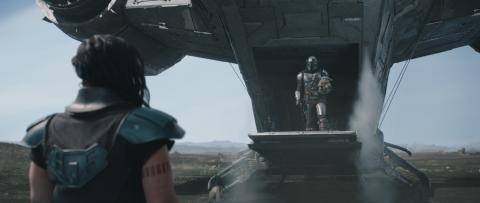
For this second season, the studio rebuilt the city and brought it to life. "Our modeling department meticulously recreated a huge marketplace that included CG buildings, awnings, different types of props and CG characters. We couldn't just use old assets we had from last season to recreate building facades; we needed to make everything feel newer than last season," Kasparian added.
Indoor and outdoor CG environments, as well set extensions, were also created for sequences taking place at the Imperial Base where our protagonists plan on blowing up the reactor. "The assets we received from Lucasfilm were built for the volume so we adjusted everything in a higher resolution so it would fit in seamlessly with the actual set," recounted Kasparian. Numerous set extensions were also created for the Imperial Base Shuttle Pad, including all of the corridors where the scenes had been filmed on blue screen. The Hybride team also created FX for the blaster fights between our heroes and the storm troopers and molten lava was also created for the heat shaft sequence. ILM took care of making the reactor blow.
Behold the massifs
The Massif are a reptilian species of dangerous hunters found on desert planets including Tatooine and Geonosis. Massifs were domesticated for sentry and guard tasks, and were used by the Tusken Raiders of Tatooine.
When The Mandalorian runs into a pack of massifs on Tatooine, his companion Cobb Vanth (Timothy Olyphant) grows nervous but when Mando begins to communicate with the massiffs they warm to him immediately and one comes up to have its head scratched. They turn from ferocious to cute in five seconds.
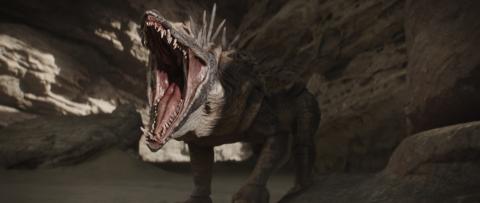
Based on concept art provided by Lucasfilm VP and Executive Creative Director Doug Chiang, Hybride artists created the CG version of the massive creatures. "Since the prop they were using on set didn't have any type of rig on it, we could use it as a reference to see how the light would react on top of the massifs," noted Kasparian. "After doing a bunch of tests we designed a model that matched the one that they had on set, then did CG variations of the Massifs so we could get 5 of them into the sequence."
"Use the Force"
In Episode 6, Hybride reunited with Director Robert Rodriguez, with whom the studio had worked with 13 times before. As Mando brings Grogu (aka "Baby Yoda") to Tython, he places him on a domed rock nestled in the center of a Stonehenge-like hilltop temple. Grogu then connects with the Force that appears in the form of a flowing blue energy. Hybride created the Force effect, and integrated it into the plates and set extensions.
"They wanted the effect to have an old-school look, similar to the optical effects in Cocoon or Ghostbusters," said Kasparian, "when they had to do energy effects back then, they'd do it with lens flares and that kind of thing so we mimicked that retro look for this."
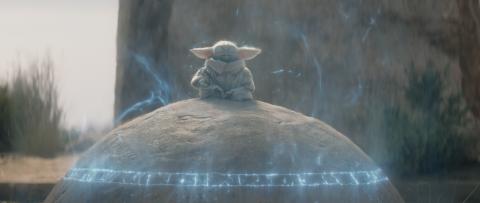
Take a ride on the Juggernaut
On the jungle planet of Morak, Mando and his companion Migs Mayfeld (Bill Burr) jump onto an armored Juggernaut vehicle and overtake it in a tunnel, but are then soon chased by pirates on skiffs. Hybride integrated the Juggernaut and skiffs into the CG backgrounds, and extended a partial Juggernaut model used on set.
"We also did a full-CG shot of the Juggernaut when the characters first see it," said Joseph Kasparian, "as well as a full-CG shot of it going into the tunnel."
To the Spaceport and beyond
In the season's final episode we find ourselves inside a spaceport where Mando reunites with his friends Bo-Katan (Katee Sackhoff) and Koska Reeves (Mercedes Varnado). The spaceport was a physical set with virtual set extensions.
As Bo-Katan pilots the lambda shuttle toward the light cruiser, Mando and Boba Fett follow in Boba's ship. As they draw the TIE Fighters away, the lambda shuttle crash-lands in the docking bay of the light cruiser. On the cruiser, they all split up to explore the ship. "The interior was massive, so we needed to extend almost every shot," added Joseph Kasparian. "The first 20 feet of the corridor was a live set, and whenever it was more than 20 feet, it was full CG." Hybride also designed and built a long platform surrounded by space. "They had something very specific in mind for that, and building it was one of our biggest tasks. There is a blaster fight as well, and a Stormtrooper falls into space from the platform. That was all work we did."
"The Mandalorian" stars Pedro Pascal, with guest stars Gina Carano, Carl Weathers and Giancarlo Esposito. Directors for the new season include Jon Favreau, Dave Filoni, Bryce Dallas Howard, Rick Famuyiwa, Carl Weathers, Peyton Reed and Robert Rodriguez. Showrunner Jon Favreau serves as executive producer along with Dave Filoni, Kathleen Kennedy and Colin Wilson, with Karen Gilchrist and Carrie Beck serving as co-executive producers. The writers for this season are Jon Favreau, Dave Filoni and Rick Famuyiwa.
LAYOUT / TRACKING
Steve Pelchat, (lead layout/tracking)
Alain Lacroix
Benoît Morin
Mashi Akiyama
Mathieu Godin
Phil Dakin
Samuel David
Samuel Loriault-Goulet
Stéphane Maillet
TEXTURE & LIGHTING
Christophe Damiano, (Lead Lighting)
Maryse Bouchard, (Lead Texture)
Julien Chabot
Yanick Gaudreau
Doréa Fontaine
Léane Morin
Mathieu Beaudoin
Myriam Ricard-Lalonde
Nicolas Leroy
Nicolas Scuntaro
Patrice Ferron-Craig
Quentin Luna
Steven Quinones-Colon
Alexandre Tessier
Audrey-Anne Surprenant
Christian Ménard
David Bélanger-Dambremont
Gabrielle Marchand
Marie-Claude Aubry
Maxime Vysniauskas
Sara Fontaine
Valérie Villeneuve
FX ANIMATORS
Danny Levesque
Bertrand Cabrol
Erwan Naudin
Francis Beauregard
Jérémie Chagnon
Julien Dubusset
Kishen PJ
Louis Desrochers
Luigi Duranti
Maxime Béliveau
Richard Clément Tam
Stéphane Arsenault
TECHNICAL DIRECTORS
Patrick Piché, (Lead Technical Director)
Bruno-Pierre Jobin
Dominic Gaudreau
Frédéric Fortin
Jimmy Caron
Mathieu Leclaire
Michel Bergeron
Yannick Tétreault
MODELERS
Marco Tremblay, (Environment Supervisor)
David Bédard
David Roberge
Mathieu Lalonde
Matthew Smith
Michaël Coutu
Miguel Berube Ouellet
Philippe Vachon
Timo Fahrbach
ANIMATORS
Alexandre Alin
Eduardo Azcue
Josef Sy
Marcus Alquéres
Neil A. Lim Sang
Stephen Cooper
William Campbell
PRESIDENT AND HEAD OF PRODUCTION
Pierre Raymond
EXECUTIVE VICE PRESIDENT
Michel Murdock
PRODUCTION VICE PRESIDENT
Thierry Delattre
HEAD OF PRODUCTION MONTREAL STUDIO
Mathieu Boucher
VISUAL EFFECTS SUPERVISOR
Joseph Kasparian
COMPUTER GRAPHICS SUPERVISORS
Christopher Ahrens
Emmanuel Pelletier
Nadège Bozzetti
Philippe Théroux
COMPOSITING SUPERVISORS
Maxime Lemieux
Michel Barrière
Olivier Beaulieu
Olivier Gravel
Simon Marinof
Thai Son Doan
VISUAL EFFECT PRODUCERS
Louise Bertrand
Richard Martin
PROJECT MANAGER
Catherine Lecavalier
ANIMATION SUPERVISOR
Kenneth Steel
VISUAL EFFECT COORDINATORS
Audrey Deschênes
Joanie Croteau
Karina Mariano
Leo-Partick Houde
Marc St-Gelais
Marlène Circé
Martine Losier
RESSOURCE COORDINATOR
Sylvain Rioux
TECHNICAL SUPPORT
Denis Verfaillie
Karim Besbes
Luc Desmarais
Mélanie Cotton
Michel Rock
Olivier Painchaud
René Filion
Stephan Gervais
COMMUNICATIONS
Sylvie Talbot
Anne Tremblay
ADMINISTRATION
Caroline Bélisle
Isabelle Desrochers
Marie Nakhlé
DIGITAL COMPOSITORS
Jérôme Foucout, (Lead Digital Compositor)
Matthieu Chatelier, (Lead Digital Compositor)
Maxime Lemieux, (Lead Digital Compositor)
Olivier Gravel, (Lead Digital Compositor)
Patrick Tassé, (Lead Digital Compositor)
Pierre Blain, (Creative Supervisor)
Alban Kasikci
Alice Pépujol
Andréanne Lamoureux
Ashish Dewan
Belly Mingmuong
Bruno Martins
Cédric Pépin
Christopher Payne
Cyril Balavoine
David Ferron
Éloi Brunelle
Elsa Lemire
Francis Pasquarelli
François Leduc
Gabriel Couture-Bojanowski
Jeanlin Guillaume
Jeffrey Jin
Jérôme Foucout
Jocelyn Maher
Julie Therrien
Juliette Compignie
Justin Hébert
Katy Savoie
Lionel Jacobs
Marc-Olivier Simoneau
Mathieu Boudreau
Matthieu Chatelier
Maxime Ferland
Ramón Ramos
Samuel Armin Gutiérrez
Samuel Lepage-Bédard
Thomas Halle
Véronique Guay
Véronique Tremblay
William Côté
Xavier Larocque
Yannick Bissonnette
VFX EDITORS
Guillaume St-Aubin
Sébastien Rioux
PAINT & ROTO
Juliette Compignie, (Lead Paint & Roto )
Mélissa Laframboise Maillé, (Lead Paint & Roto )
Alexandra Dennie
Anne Fortin
Charles-Étienne D'Amours
Christophe Trudel
Dominique Richer
Érika Normandin
James Daniel Haines
Jeff Blouin
Marie-Eve St-Amour
Miguel Basulto
Sylvain Régnié
MOTION GRAPHICS
Edouard Buttiero
CHARACTER RIGGING
Mark Masson, (Lead Character Rigging)
David Thomlison
Stephane Jean-Mary
I/O TECHNICIANS
Jonathan Perth
Jordan Picotte
Samuel Cardinal